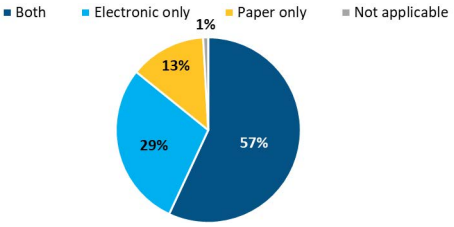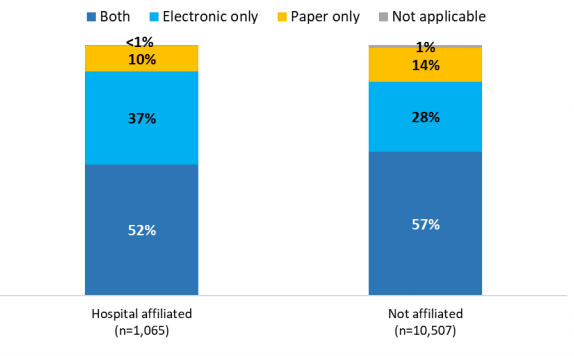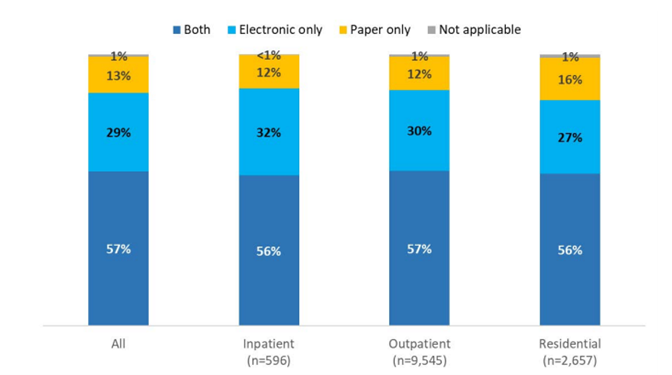More than 20 million Americans suffer from a substance use disorder (SUD) each year (1). For these individuals, treatment is designed to help stop or reduce harmful substance misuse, improve health and social function, and manage risk for relapse (1). Electronic technologies, such as electronic health records (EHRs), enable individuals and their providers to more easily manage and exchange treatment records to support care coordination. Effective use of these technologies can also improve quality of care, reduce treatment gaps, and provide cost savings to health systems (1). In 2017, the Substance Abuse and Mental Health Services Administration (SAMHSA) surveyed 13,585 U.S. substance abuse treatment centers about their use of computers or electronic resources to store and exchange treatment records. This brief presents results that show variation in the methods used to store and exchange health records across treatment centers. These results provide a baseline for understanding how treatment centers manage client health information and whether they use electronic methods to do so.
HIGHLIGHTS
- Three in ten substance abuse treatment centers use only electronic methods to store and maintain health records.
- Centers affiliated with hospitals, operated by the federal government, or those that operate opioid treatment programs have the highest rates of storing health records electronically.
- Fewer than one in ten centers use only electronic methods to send or receive client health information
Three in ten substance abuse treatment centers use only electronic methods to store and maintain health records.
Figure 1: Percent of substance abuse treatment centers that store and maintain health records by electronic or paper methods, 2017.

SOURCE: 2017 National Survey of Substance Abuse Treatment Services (N-SSATS).
NOTES: N = 13,585 survey respondents; n = 11,573 responded to this question. Responses to question 27 of 2017 N-SSATS (see Appendix). See Definitions for full accounting of electronic and paper methods. Both = centers use both electronic and paper methods.
★ About 6 in 10 centers use a combination of both electronic and paper methods to store and maintain health records.
★ Over 10 percent of centers use only paper methods to store and maintain health records.
Hospital-affiliated centers store health records electronically at higher rates than unaffiliated centers.
Figure 2: Percent of substance abuse treatment centers that store health records using electronic or paper methods by hospital affiliation, 2017.

SOURCE: 2017 National Survey of Substance Abuse Treatment Services (N-SSATS).
NOTES: N = 13,585; n = 11,573 responded to this question. Responses to question 27 of 2017 N-SSATS (see Appendix). See Definitions for full accounting of electronic and paper methods. See Definitions for determination of hospital affiliation. Both = centers use both electronic and paper methods.
★ Thirty-seven percent of hospital-affiliated centers only store health records electronically, compared to 28 percent of unaffiliated centers.
★ Ten percent of hospital-affiliated centers use only paper to store health records, compared to 14 percent of unaffiliated centers.
Centers operated by the federal government have the highest rates of storing health records electronically.
Figure 3: Percent of substance abuse treatment centers that store health records using electronic or paper methods by facility operator, 2017.

SOURCE: 2017 National Survey of Substance Abuse Treatment Services (N-SSATS).
NOTES: N = 13,585; n = 11,573 responded to this question. Responses to question 27 of 2017 N-SSATS (see Appendix). See Definitions for full accounting of electronic and paper methods. See Definitions for determination of facility operator. Veterans Administration and Department of Defense facilities are considered operated by the federal government. Both = centers use both electronic and paper methods.
★ A higher percentage of residential treatment centers use paper methods to store and maintain health records than inpatient and outpatient treatment centers.
★ About the same percentage of inpatient and outpatient treatment centers use electronic methods to store and maintain records.
There are no large differences across inpatient, outpatient and residential treatment centers in the use of electronic and paper methods to store and maintain health records.
Figure 4: Percent of substance abuse treatment centers that store health records using electronic or paper methods by type of care provided by center, 2017.

SOURCE: 2017 National Survey of Substance Abuse Treatment Services (N-SSATS).
NOTES: N = 13,585; n = 11,573 responded to this question. Some facilities can choose more than one treatment setting. There is some double counting of respondents when a facility provides more than one type of care. Responses to question 27 of 2017 N-SSATS (see Appendix). See Definitions for full accounting of electronic and paper methods. See Definitions for determination of treatment center facility type. Both = centers use both electronic and paper methods.
★ A higher percentage of residential treatment centers use paper methods to store and maintain health records than inpatient and outpatient treatment centers.
★ About the same percentage of inpatient and outpatient treatment centers use electronic methods to store and maintain records.
Centers that operate an opioid treatment program store and maintain health records using any electronic method at a higher rate than centers that do not operate opioid treatment programs
Figure 5: Percent of substance abuse treatment centers that store health records using electronic or paper methods by whether or not the center operates an opioid treatment program, 2017.

SOURCE: 2017 National Survey of Substance Abuse Treatment Services (N-SSATS)
NOTES: N = 13,585; n = 11,573 responded to this question. Responses to question 27 of 2017 N-SSATS (see Appendix). See Definitions for full accounting of electronic and paper methods. See Definitions for opioid treatment program. Both = centers use both electronic and paper methods.
★ Ninety-five percent of centers that operate an opioid treatment program use any electronic method to store and maintain health records compared to 85 percent of centers that do not operate an opioid treatment program.
★ Facilities that did not operate an opioid treatment program were over two times more likely than centers with an opioid treatment program to use only paper methods to store and maintain health records.
One in four substance abuse treatment centers use only paper methods to send and receive client health information.
Figure 6: Percent of substance abuse treatment centers that send and receive health information by electronic or paper methods, 2017.

SOURCE: 2017 National Survey of Substance Abuse Treatment Services (N-SSATS)
NOTES: N = 13,585; n = 11,573 responded to this question. Responses to question 27 of 2017 N-SSATS (see Appendix). See Definitions for full accounting of electronic and paper methods. See Appendix, Table 3 for a break out of send and receive by the same center characteristics in figures 2 through 5. Both = centers use both electronic and paper methods.
★ About double the number of centers use only paper methods to send and receive client health information than store and maintain client health information.
★ Fewer than 10 percent of centers use only electronic methods to send and receive client health information – a third the rate of centers who use only electronic methods to store health information.
Summary
In 2017, the Substance Abuse and Mental Health Services Administration (SAMHSA) surveyed 13,585 U.S. substance abuse treatment centers through the National Survey of Substance Abuse Treatment Services (N-SSATS) about their use of computers or electronic resources to store and exchange treatment records. More than half of centers nationwide use a combination of both electronic and paper methods to store and exchange client health information. Three in ten centers use only electronic methods to store and maintain health information. More than half of centers also use both electronic and paper methods to send or receive client health information. However, less than one in ten centers use only electronic methods.
The methods used to store and maintain health records varies across different types of centers. Centers affiliated with hospitals use only electronic methods to store records at higher rates than unaffiliated centers. Use also varies by facility operator. Centers operated by the federal government, predominantly through the Veterans Administration and Department of Defense, use only electronic methods to store records more than non-federal operated centers. While 3 in 10 centers nationwide use only electronic methods to store records, 7 in 10 centers operated by the federal government do so.
While use of electronic methods to store and maintain health information varies across hospital affiliation and facility operator, it does not vary among facility treatment types. Inpatient, outpatient and residential treatment centers vary little in their use of electronic methods to store and maintain health information. Residential treatment centers use only paper methods at a slightly higher rate than other centers.
Centers that operate an opioid treatment program use electronic methods to store and maintain health information more than centers that do not operate an opioid treatment program. About 95 percent of these centers use electronic methods to store and maintain health information; 5 percent use only paper methods to do so. SAMHSA certification of opioid treatment programs requires centers to establish and maintain recordkeeping systems to adequately document and monitor patient care (2). These systems must comply with federal and state reporting requirements when treating opioid use disorder, and may be associated with higher reported use of electronic methods to store and maintain health information.
These results highlight the important role that federal programs and initiatives might have played in enabling substance abuse treatment centers with the capability to store and exchange treatment records. Programs like the Promoting Interoperability Program (formerly the Medicare and Medicaid Electronic Health Records (EHR) Incentive Programs), provided incentive payments to eligible hospitals and professionals to adopt and use certified EHRs. Today, nearly all (95%) non-federal acute care hospitals and about 80 percent of office-based physicians in the United States use a certified EHR system (3, 4). As a result, federally-operated centers benefit from the investment made by the federal government to digitize health care, as do centers affiliated with U.S. hospitals, who benefit from federal health IT investment incentives. However, many substance abuse treatment centers have not directly benefitted from these federal incentives to adopt certified health IT.
Other efforts, including center education and outreach, are also underway. The Health IT Playbook, published by the Office of the National Coordinator for Health Information Technology (ONC), provides educational materials and delivers tips for adopting and implementing health IT in behavioral health care settings.
The N-SSATS does not specifically capture EHR or health IT use among centers. However, the use of electronic methods to perform certain information management tasks is a good proxy to understand how centers are managing client records, and exchanging data with its care partners. These results provide an initial understanding of how substance abuse treatment centers manage their client’s health information. Future SAMHSA surveys will continue to measure centers’ information management practices and specifically measure centers’ use of EHRs.
Definitions
Non-federal acute care hospital: Includes acute care general medical and surgical, and cancer hospitals owned by private/not-for-profit, investor-owned/for-profit, or state/local government and located within the 50 states and District of Columbia.
Substance abuse treatment center: A U.S. facility, both public and private, that provides alcohol and/or drug abuse treatment services throughout the 50 states, the District of Columbia, and other jurisdictions.
Electronic methods: Electronic resources used to accomplish work associated with a clinical, administrative or information management activity, as listed in the Appendix. Electronic resources include tools such as electronic health records and web portals. Electronic resources do not include e-fax, pdf, or scanned documents. These are considered paper documents.
Paper methods: All non-electronic resources used to accomplish work associated with a clinical, administrative or information management activity, as listed in the Appendix. Non-electronic resources include e-fax, pdf, or scanned documents. These are considered paper documents.
Hospital affiliation: Hospital affiliation determined by responses to survey question: Is this facility a hospital or located in or operated by a hospital? Treatment centers that responded “Yes” were categorized as affiliated with a hospital.
Facility operator: Operator determined by responses to survey question: Is this facility operated by? Respondents were instructed to select one of six possible responses: private for-profit organization; private non-profit organization; state government; local, county, or community government; tribal government; and federal government. Operator was determined using the selection made by the respondent.
Inpatient: Treatment provided in a center located in a hospital. Treatment may involve an overnight stay.
Outpatient: Treatment does not involve an overnight stay. Clients are treated and discharged the same day.
Residential: Treatment involves client living at the facility for a set amount of time.
Opioid Treatment Program: In the United States, the treatment of opioid dependence with medications is governed by the Certification of Opioid Treatment Programs. Opioid treatment programs are accredited and certified by SAMHSA. Programs provide medication-assisted treatment (MAT) for people diagnosed with an opioid-use disorder. MAT patients also must receive counseling, which can include different forms of behavioral therapy.
Data Source and Methods
Data are from the Substance Abuse and Mental Health Services Administration (SAMHSA) 2017 National Survey of Substance Abuse Treatment Services (N-SSATS):
Substance Abuse and Mental Health Services Administration, National Survey of Substance Abuse Treatment Services (N-SSATS): 2017. Data on Substance Abuse Treatment Facilities. Rockville, MD: Substance Abuse and Mental Health Services Administration, 2018.
The 2017 N-SSATS was conducted between February and December 2017, with a reference date of March 31, 2017. It is the 40th in a series of national surveys that began in the 1970s. The surveys were designed to collect data on the location, characteristics, and use of alcohol and drug abuse treatment facilities and services throughout the 50 states, the District of Columbia, and other jurisdictions. The Center for Behavioral Health Statistics and Quality, SAMHSA, U.S. Department of Health and Human Services, plans and directs the N-SSATS.
The 2017 N-SSATS facility universe totaled 17,029 facilities, including all 16,816 active treatment facilities on SAMHSA’s Inventory of Behavioral Health Services at a point four weeks before the survey reference date, and 213 facilities that were added by state substance abuse agencies or otherwise discovered during the first five months of the survey. Of these facilities, 1,501 facilities were found to be ineligible for the survey because they had closed or did not provide substance abuse treatment or detoxification. Of the remaining 15,528 eligible facilities, 13,857 completed the survey and 13,585 were included in this report.
Among these 13,385 respondents, 2,012 respondents did not provide a method of how it stores and maintains client health and/or treatment records; 2,009 did not provide a method of how it sends client health and/or treatment information; and 2,034 did not provide a method of how it receives client health and/or treatment information. The denominator used in figures 1 through 6 excludes these missing responses. A simple quality test was completed to determine the distribution of these missing responses. The test did not determine that missing responses were disproportionately distributed among centers among these characteristics: facility operator, hospital affiliation, whether the center is a residential facility, provides detoxification services or offers an opioid treatment program.
There were three modes of data collection employed: a secure web-based questionnaire, a paper questionnaire sent by mail, and a telephone interview. Ninety-two percent responded using the web-based questionnaire; 1 percent replied by mail; and 6 percent responded through the telephone interview.
More information about the survey can be found through the official SAMHSA website: https://www.samhsa.gov/data/data-we-collect/nssats-national-survey-substance-abuse-treatment-services.
This brief reports results from the 13,585 responses to the 2017 survey. Non-responses to survey questions are included in figures and tabulations.
References
1. U.S. Department of Health and Human Services (HHS), Office of the Surgeon General, Facing Addiction in America: The Surgeon General’s Report on Alcohol, Drugs, and Health. Washington, DC: HHS, November 2016.
2. Certification and Treatment Standards for Opioid Treatment Programs. 42 C.F.R. Part 8 Subpart C.
3. Office of the National Coordinator for Health Information Technology. 'Non-federal Acute Care Hospital Electronic Health Record Adoption,' Health IT Quick-Stat #47. https://dashboard.healthit.gov/quickstats/pages/FIG-Hospital-EHR-Adoption.php. September 2017.
4. Office of the National Coordinator for Health Information Technology. 'Office-based Physician Electronic Health Record Adoption,' Health IT Quick-Stat #50. https://www.healthit.gov/data/quickstats/office-based-physician-electronic-health-record-adoption. January 2019
Acknowledgements
The authors are with the Office of the National Coordinator for Health Information Technology, Office of Technology, Division of Technical Strategy and Analysis. The data brief was completed under the direction of Talisha Searcy, Director of Research and Evaluation for the Office Technology. Other staff that contributed to this document include: Vaishali Patel, Senior Advisor, ONC; Samantha Meklir, Senior Policy Advisor, ONC; and Herman A. Alvarado, Data Collection Manager, N-SSATS/N-MHSS.
Suggested Citation
Barker, W & Johnson, C. (July 2020). ONC Data Brief, no.52. Variation in Methods for Health Information Management among Substance Abuse Treatment Centers, 2017. Office of the National Coordinator for Health Information Technology: Washington DC.
Appendix
Appendix Table 1: Survey questions assessing health information management among treatment centers.
Figures 1-6 visualize responses to question 27 from the 2017 N-SSATS:
For each of the following activities, please indicate if staff members routinely use computer or electronic resources, paper only, or a combination of both to accomplish their work.
The table, below, lists those work activities used in this analysis and the response options.
Appendix Table 2: Percent of substance abuse treatment centers that store and maintain health records by electronic or paper methods, 2017.
| |||||
| |||||
Appendix Table 3: Percent of substance abuse treatment centers that use electronic and paper methods to send and receive client health information, 2017.


![Variation in Methods for Health Information Management among U.S. Substance Abuse Treatment Centers, 2017 [pdf]](/sites/default/files/2021-07/substance-abuse-treatment-center-health-information-management-2017.png)